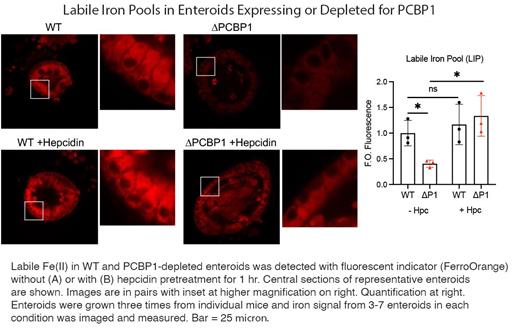Iron is an essential nutrient required by all cells but used primarily for red blood cell production. Because humans have no effective mechanism for ridding the body of excess iron, the absorption of dietary iron must be precisely regulated. The critical site of regulation is the transfer of iron from the absorptive enterocyte to the portal circulation via the sole iron efflux transporter, ferroportin (FPN). Here we report that poly(rC)-binding protein 1 (PCBP1), the major cytosolic iron chaperone, is necessary for the regulation of iron flux through FPN in the intestine of mice. PCBP1 binds iron-glutathione complexes in the cytosol of cells and delivers the iron to ferritin, the iron storage protein, to iron centers in enzymes, and to iron-sulfur cluster chaperones. PCBP1 also limits the chemical reactivity of iron, thereby limiting iron-catalyzed oxidative damage in cells.
To explore the role of PCBP1 in dietary iron absorption, we developed mice with an inducible, enterocyte-specific deletion of PCBP1. Mice lacking PCBP1 in the intestinal epithelium exhibit low levels of enterocyte iron, poor retention of dietary iron in enterocyte ferritin, and excess efflux of iron through FPN. Kinetic studies of iron transport using a stable isotope ( 57Fe) coupled with a mini-hepcidin that blocks FPN activity demonstrated that PCBP1 deletion had no effect of intestinal iron uptake but caused high rates of iron efflux through FPN. Surprisingly, excess iron efflux occurred despite lower levels of FPN protein in enterocytes and upregulation of the iron regulatory hormone hepcidin. PCBP1 deletion and the resulting unregulated dietary iron absorption led to poor growth, severe anemia on a low iron diet and liver oxidative stress with iron loading on a high iron diet.
To investigate the roles of PCBP1 more precisely in enterocytes, we developed 3-D organoid cultures from intestinal epithelium which functionally expressed the major iron trafficking proteins: divalent metal transporter 1, PCBP1, ferritin, transferrin receptor 1 and FPN. Ex vivo culture of wild-type and PCBP1-depleted enteroids demonstrated normal patterns of FPN expression and hepcidin-mediated turnover. However, fluorescence measurements of kinetically labile iron pools in enteroids competent or blocked for FPN iron efflux indicated that PCBP1 dramatically altered efflux activity. PCBP1 functioned as a cytosolic buffer for iron, binding and retaining iron and thereby keeping “free” iron at very low levels. This low concentration of free iron limited its availability for FPN-mediated efflux and allowed hepcidin-mediated changes in FPN levels to regulate the amount of iron exported from the enterocyte. Thus, by binding enterocyte iron, PCBP1 reduces the concentration of unchaperoned, “free” iron to a low level. This low level of cytosolic free iron is necessary for hepcidin-mediated regulation of FPN activity.
Disclosures
No relevant conflicts of interest to declare.


This feature is available to Subscribers Only
Sign In or Create an Account Close Modal